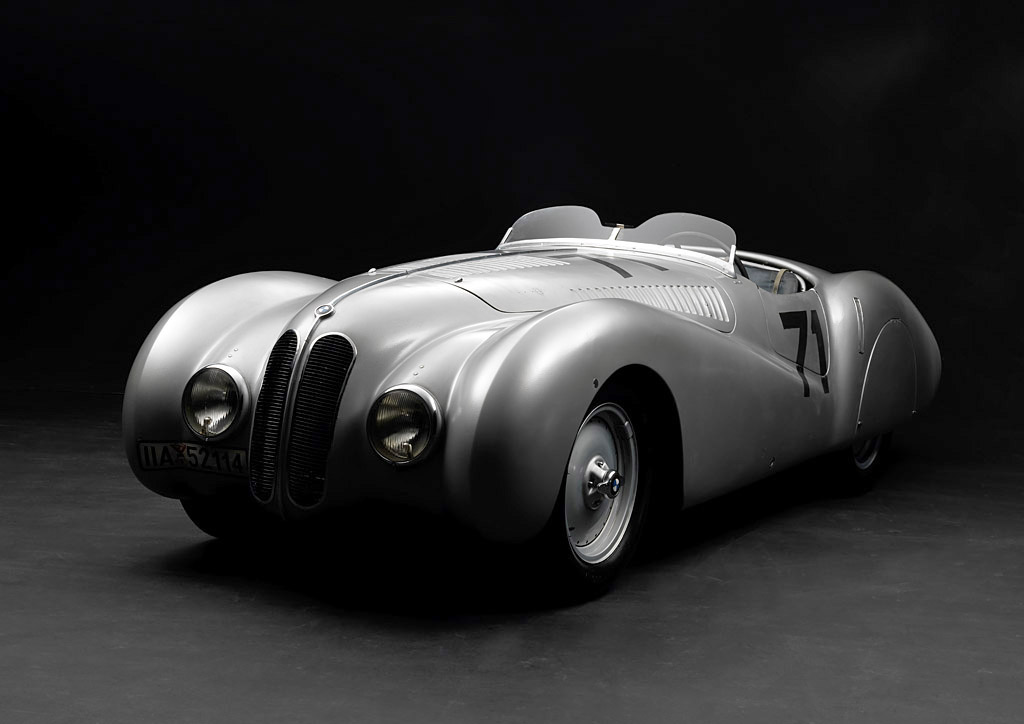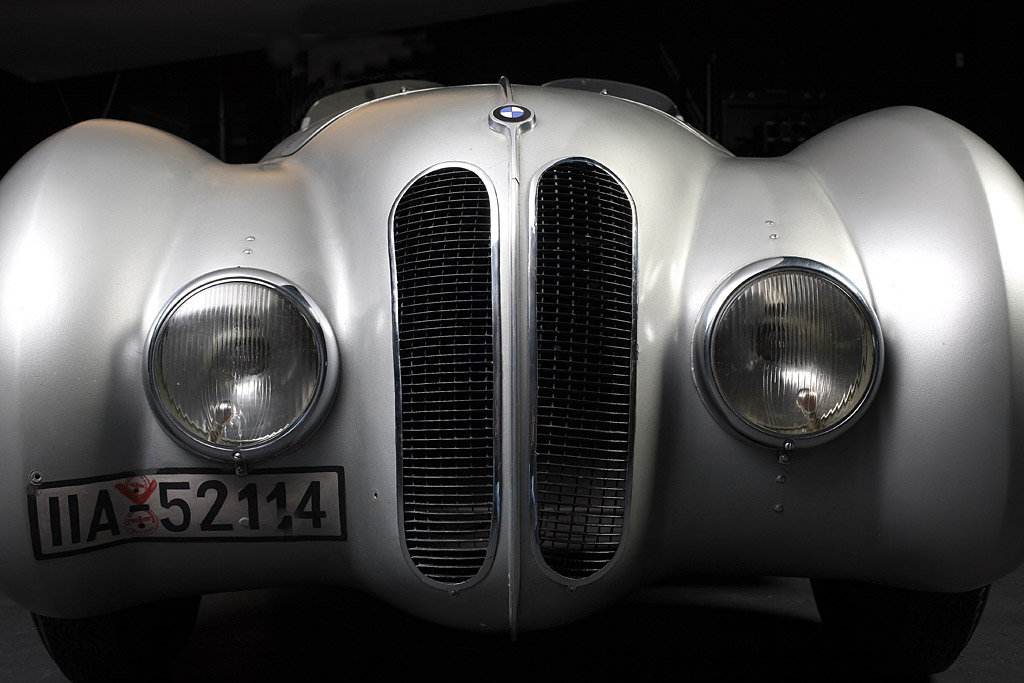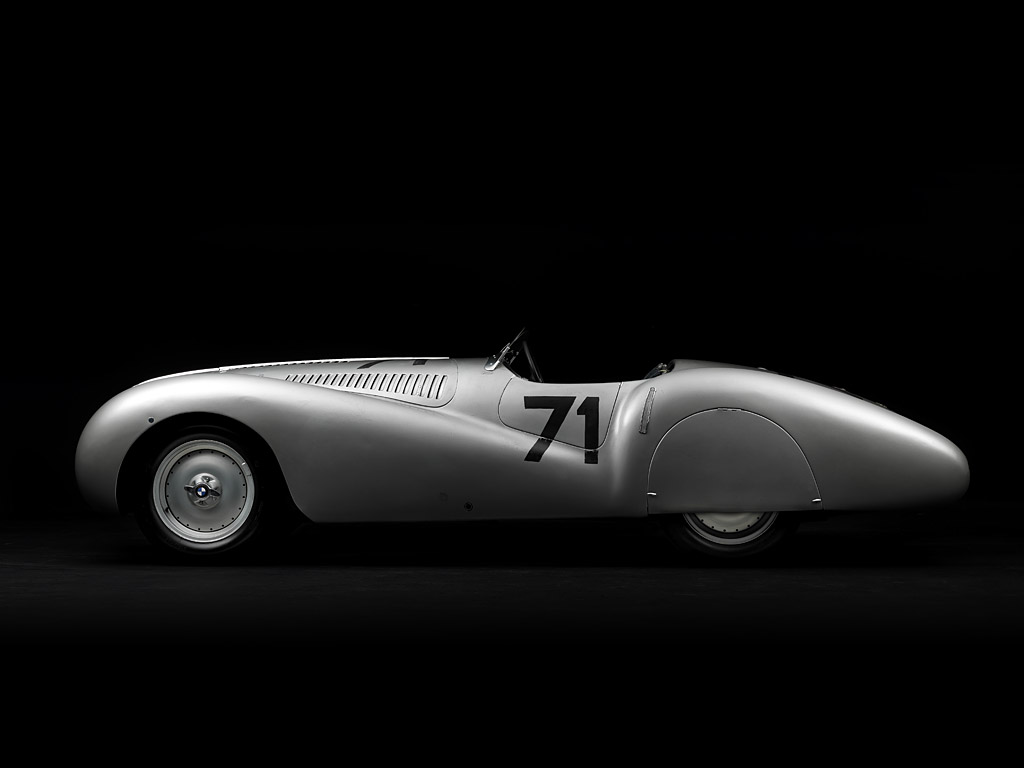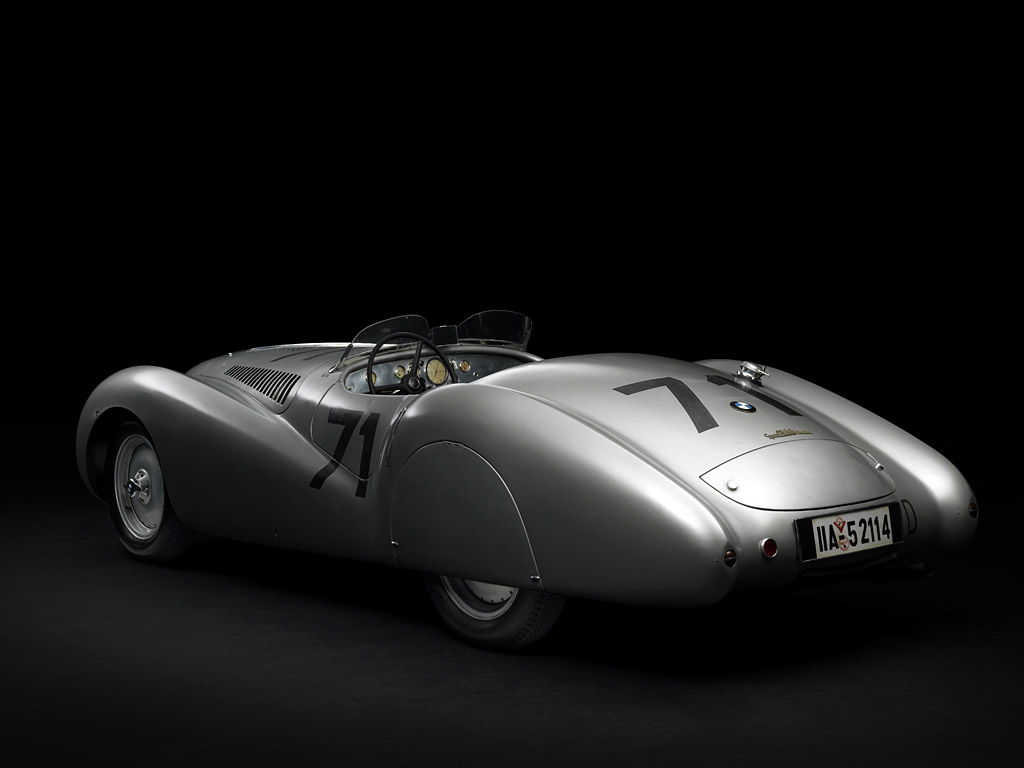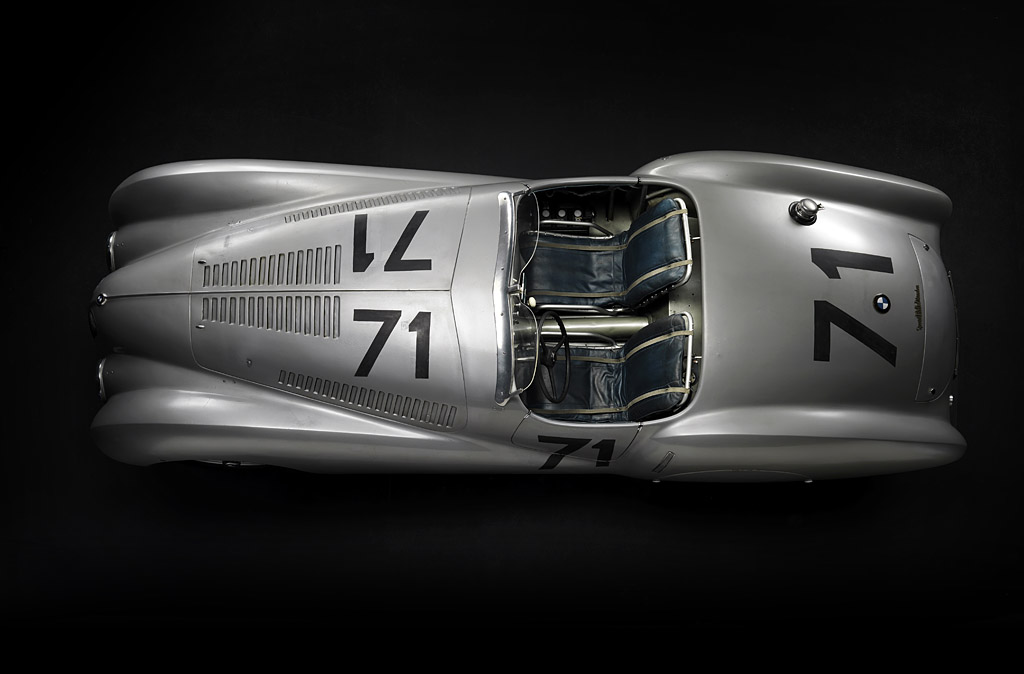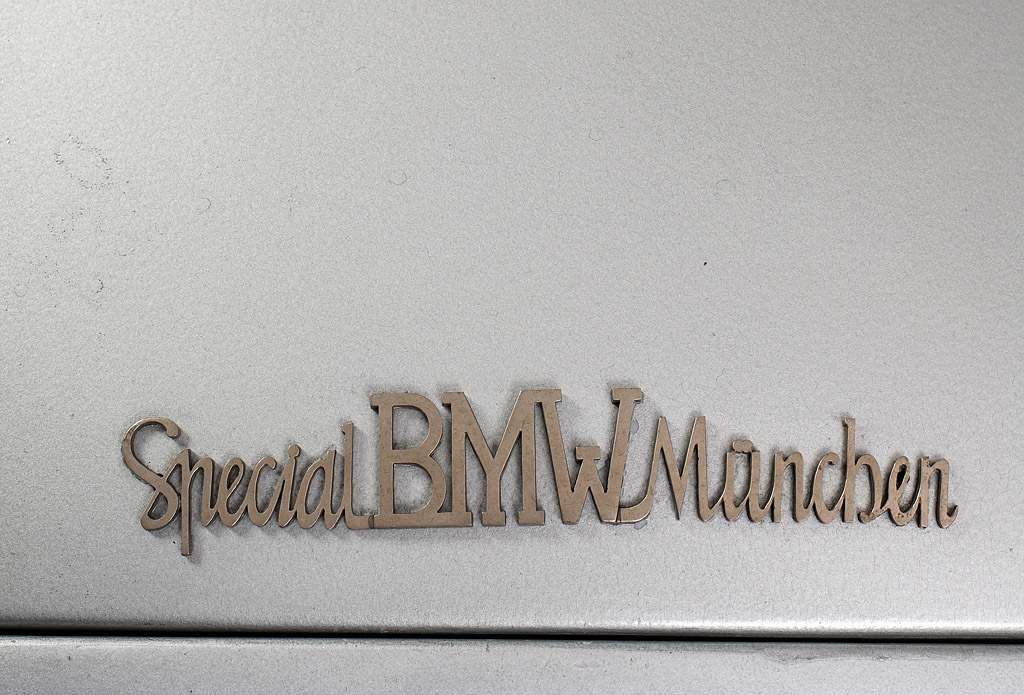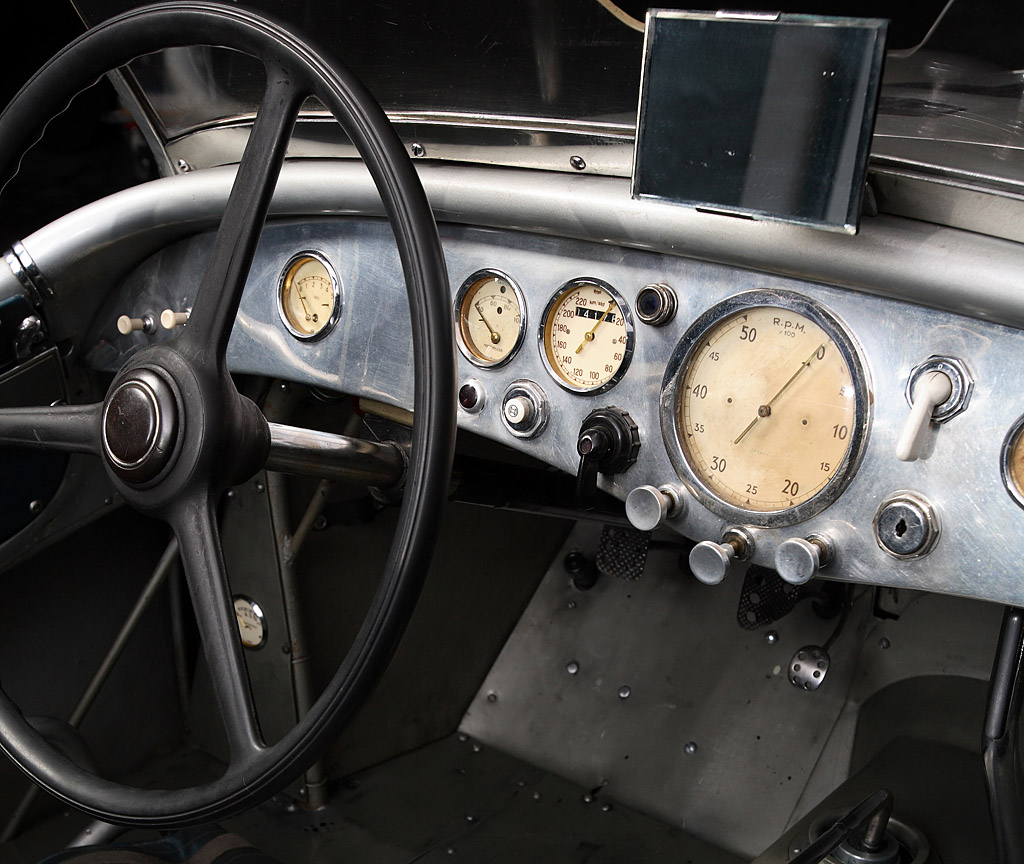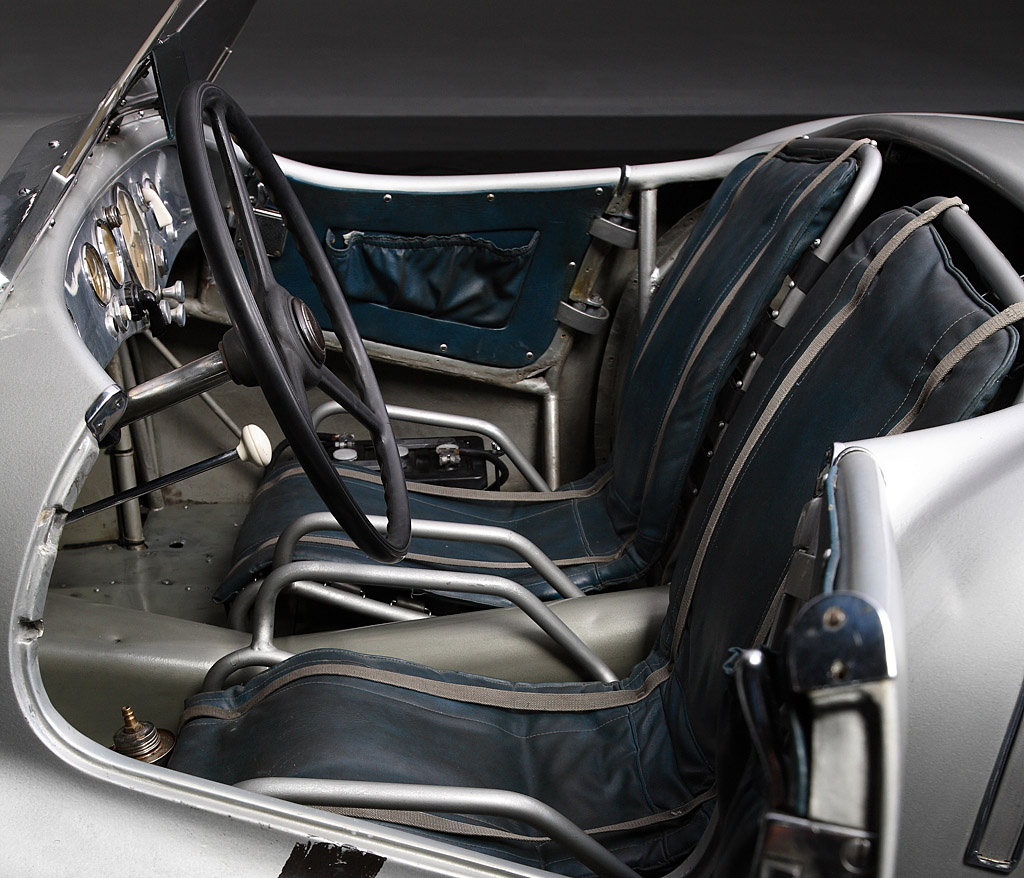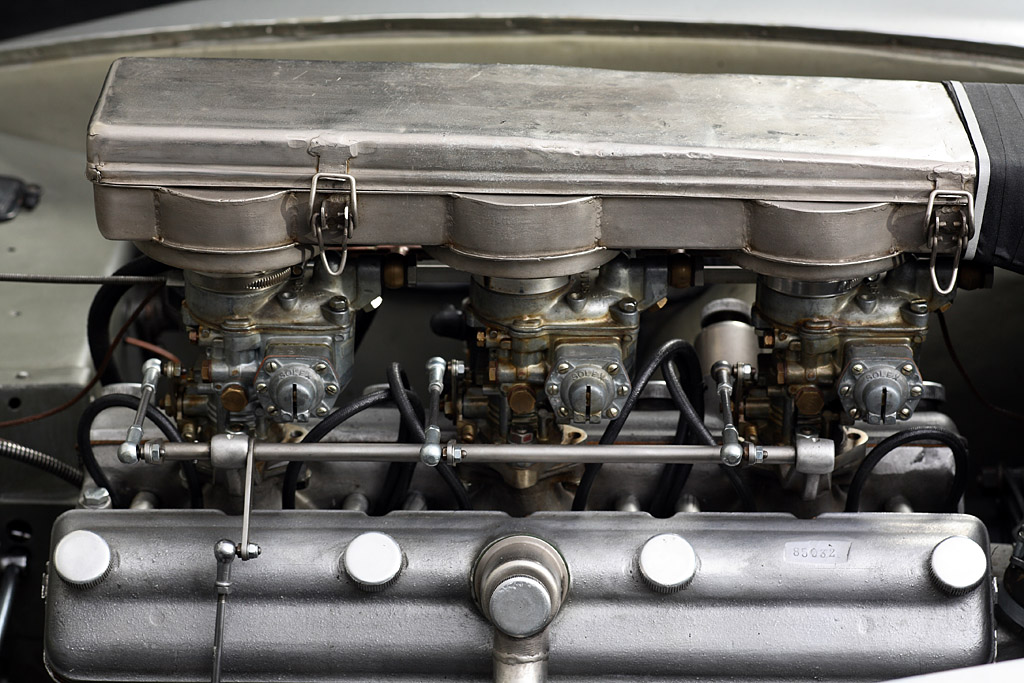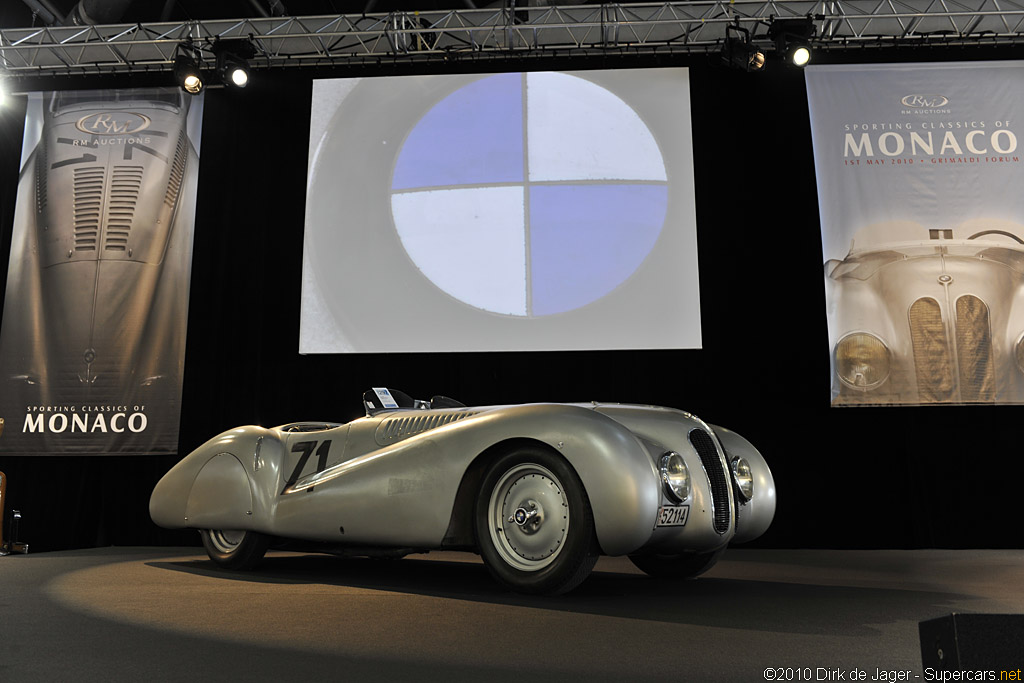1937 BMW 328 Mille Miglia ‘Büegelfalte’
For the 1940 Mille Miglia, BMW`s design department, Künstlerische Gestaltung, produced this one-of prototype with a streamlined body. It was driven by Count Giovanni Lurani and Franco Cortese and placed 6th overall. At the same race, two similar cars were built by Touring of Milan and a 328 Coupe won the Mille Miglia outright. The name Büegelfalte comes from the ‘trouser crease’ at the top of the fenders which are unique to this car.
The body was fitted to the car in 1940, after it had already contested Le Mans and Mille Miglia as a factory car.
Only one of the streamlined 328s came from BMW in Munich directly while the rest were outsourced to Touring in Milan. The cars finished in Milan are sometimes refereed to the Series II Mille Miglia Roadster. These cars were an exercise in light weight design with many magnesium-alloy pieces such as the body, seat frames and disc wheels. Aditional upgrades included a strengthened Hurth Transmission.
See full 1937 BMW 328 Mille Miglia ‘Büegelfalte’ Gallery here
After the war, the sole Büegelfalte survived in Russian hands and was eventually sold. For many years it was cared for by BMW’s own technicians while they replicated an exact copy. In 2010 it was offered by RM Auctions for their Sporting Classics of Monaco sale. Below is an except of the description:
RM Auctions Description.
In preparation for the 1940 Mille Miglia BMW built an aerodynamic coupe and a lightweight open roadster. The streamlined roadster was based on chassis 85032, extensively modified to lower the engine and driveline in the chassis to reduce the body’s frontal area and lower the center of gravity to improve handling. Its concept is credited to BMW designer Wilhelm Mayrhofer and was tested in Dr. Kamm’s wind tunnel. Its long, tapered tail took advantage of the lowered engine and profile.
Aside from its low silhouette and flowing fenders, the prototype roadster’s fenders had a pronounced ridge along their tops. It resembled the crease in a pair of ironed trousers and gave the unique car the name it still carries today, Bügelfalte or “ironing crease.” Its panels were formed over an armature of small diameter tubing, the superleggera system patented by Carrozzeria Touring in Milan. Welded to the twin tube frame, the body structure lends substantial rigidity to the Bügelfalte’s chassis while weighing just 103 kg.
In autumn 1939, the car was dismantled at the BMW factory’s racing division in Milbertshofen before being extensively re-engineered and used as the basis for even more streamlined bodywork in preparation for the 1940 season and the Mille Miglia in particular. To that end, BMW built both an aerodynamic coupé and this lightweight open roadster.
Extensive modifications to 85032 included lowering the engine and driveline in the chassis to reduce the body’s frontal area and lower the centre of gravity to improve handling. Its design is credited to Wilhelm Kaiser, a very experienced member of BMW’s new design department, headed by chief stylist Wilhelm Meyerhuber. A 1:10 scale model was tested in the wind tunnel of pioneering aerodynamicist Prof. Dr.-Ing. Wunibald Kamm, with a long, tapered tail that took advantage of the lowered engine and profile.
The stunning bodywork was hand-formed by “Blasi” Huber in Ernst Loof’s racing department and made from a lightweight aluminium-magnesium alloy (Al MG 3-4) frequently used in high performance aircraft construction. Aside from its low silhouette and flowing fenders, the prototype roadster’s fenders had a pronounced ridge along their tops. It resembled the crease in a pair of ironed trousers and gave the unique car the name it still carries today, Bügelfalte or “ironing crease.”
Its panels were formed over an armature of small diameter tubing, preceding the similar superleggera system patented by Carrozzeria Touring in Milan years later. Welded to the twin tube frame, the body structure lends substantial rigidity to the Bügelfalte’s chassis while weighing just 103 kg. The wheel wells were made of the same lightweight aluminium-magnesium alloy, and the inside panels were partially made of pure magnesium. In fact, the seat frames were pure magnesium as well. This was the absolute cutting edge of racing technology and helped bring the car’s curb weight down to just 725 kgs. An extraordinary achievement, then and now!
The engine itself was completely upgraded in all respects, now producing 130 hp, a full 50 hp more than the standard engine of a road-going 328. A larger oil pan was fitted, as were an additional side-mounted oil cooler, a 100-litre fuel tank and a special air box that helped draw in air at high speed. This motor received a magnesium valve cover and was mated to a strengthened race-ready Hurth transmission with gearbox housing partially made of magnesium, as was the differential with a 3.44:1 gear ratio.
Magnesium was even used in the braking system, comprised of Alfin drum brakes with a Duplex system front and rear. The 17-inch steel disc wheels have riveted light metal rings, and the tyres were specially made by Continental for the Mille Miglia, so the car could go the entire distance without changing tyres. In true racing fashion, the rear leaf spring suspension was adjustable, controlled with additional stabilising bars. Even the hubs were super-light special edition units, as was much of the hardware, aluminium nuts, screw heads and the like.
Following its completion at BMW’s Milbertshofen works, the Bügelfalte BMW was tested on the autobahns near BMW’s Munich headquarters. One can only imagine what contemporary motorists must have thought as this space-age streamliner blasted by at unheard-of speeds!
The coachwork of two more roadsters and a second streamlined coupé was entrusted to Touring in Milan, which had the capacity of finishing them before the 1940 Mille Miglia. It should be noted that these two “second series” Touring-bodied roadsters had their complete mechanics and tubular substructure completed in Munich, before the bodywork was completed in Milan. As such, they did not have the characteristic “trouser crease” fenders.
Held over nine laps of a triangular 165 km circuit between Brescia, Mantua and Cremona on April 28, 1940, in the brief interlude between the declaration of war by France and Britain and the German invasion of France when Italy was still officially neutral, the 1940 Mille Miglia saw competitors from all four nations assemble in an uneasy sporting moment. They included two Delage D611s entered by the British importer, Watney, four Alfa Romeo 6C 2500s and two Auto Avio Costruzione 815s entered by Enzo Ferrari. They were matched against the team of five BMW 328s with tuned engines reputedly making 135 bhp at 5,500 rpm.
The Munich-bodied coupe was entrusted to Count Giovanni Lurani/Franco Cortese while its Touring-bodied counterpart was in the capable hands of Count Fritz Huschke von Hanstein/Walter Bäumer. The Touring-bodied roadsters were driven by Adolf Brudes/Ralph Roese and Willi Briem/Uli Richter while the original “Trouser Crease” roadster was handled by 1939 Le Mans class winner Hans Wencher and Rudolf Scholz.
Von Hanstein set a furious pace from the outset with Lurani soon passing Piero Taruffi’s Delage and Giuseppe Farina’s Alfa Romeo. On the third lap Von Hanstein averaged 174.102 km/h. Lurani began to have fuel system problems which eventually sidelined him but the three BMW roadsters were more than capable of matching the speed of the Alfa Romeo coupes. Comfortably in the lead after Taruffi’s Delage retired with engine trouble and Comotti’s Delage caught fire, Von Hanstein relaxed his pace and cruised to the victory, finishing over 16 minutes ahead of Farina’s Alfa.
The BMW roadsters finished third, fifth and sixth with the “Trouser Crease” roadster of Wencher and Scholtz just a minute behind the fifth place car. It was an epic triumph for the Munich marque.
The BMW team attempted to take part in another race at Kronstadt but the onset of the shooting war intervened and the cars were returned to Munich.
During the war the Bügelfalte roadster was given to Albert Speer, the Reichsminister für Bewaffnung und Munition (Armaments and Munitions.) Remarkably, it survived five years of world war and was seized by Russia as reparations. The Russians awarded it to Artiom Ivanovich Mikoyan, head of the Mikoyan i Gurevich Design Bureau, creator of the famed MiG fighters. Mikoyan let his son use it but the boy’s escapades eventually exhausted his father’s patience and he traded the Bügelfalte in 1972 to Guido Adamson of Riga, Latvia, for a Lada, a vehicle much less inclined to excite the fantasies of a young man.
With the collapse of the “Iron Curtain” Adamson drove the Bügelfalte from Riga to Munich and entrusted it to BMW’s care, using it occasionally, most particularly in the 1991 Mille Miglia Storica where it was featured on a BMW poster commemorating the event.
1937 BMW 328 Mille Miglia ‘Büegelfalte’ Gallery
See full 1937 BMW 328 Mille Miglia ‘Büegelfalte’ Gallery here
In Detail
| type | Racing Car |
| released at | 1940 Mille Miglia |
| built at | Milbertshofen, Germany |
| body stylist | Wilhelm Mayrhofer |
| coachbuilder | BMW |
| production | 1 |
| predeccesor | 1936 BMW 328 Roadster |
| succeccesor | 1941 BMW 328 Berlin-Rome Roadster |
| engine | Inline-6 |
| position | Front, Longitudinal |
| aspiration | Natural |
| fuel feed | three Downdraft Solex Carburetors |
| displacement | 1971 cc / 120.28 in³ |
| power | 100.7 kw / 135 bhp @ 5500 rpm |
| specific output | 68.49 bhp per litre |
| bhp/weight | 186.21 bhp per tonne |
| body / frame | Aluminum/Magnesium Alloy over Steel Chassis |
| driven wheels | RWD |
| wheel type | Aluminium-Magnesium Discs |
| front tires | Continental |
| rear tires | Continental |
| front brakes | Alfin Drums |
| rear brakes | Alfin Drums |
| f suspension | Independent w/Transverse Leaf Springs, Tubular Shock Absorbers |
| r suspension | Live Axle w/Semi-Elliptical Leaf Springs, Tubular Shock Absorbers |
| curb weight | 725 kg / 1599 lbs |
| wheelbase | 3400 mm / 133.9 in |
| transmission | Hurth 4-Speed Manual |
| final drive | 3.44:1 |
| fuel capacity | 100 litres or 26.40 gal. |
| key drivers | Count Giovanni Lurani, Franco Cortese |
Auction Sales History
1937 BMW 328 Mille Miglia ‘Büegelfalte’ – did not sell for €4,300,000 During the war, the Bügelfalte roadster was given to Albert Speer, the Reichsminister für Bewaffnung und Munition (Armaments and Munitions). Remarkably, it survived five years of world war and was seized by Russia as reparations. The Russians awarded it to Artiom Ivanovich Mikoyan, head of the Mikoyan i Gurevich Design Bureau, creator of the famed MiG fighters. Mikoyan let his son use it, but the boy’s escapades eventually exhausted his father
’s patience, and he traded the Bügelfalte in 1972 to Guido Adamson of Riga, Latvia, for a Lada, a vehicle much less inclined to excite the fantasies of a young man.
With the collapse of the “Iron Curtain,” Adamson drove the Bügelfalte from Riga to Munich and entrusted it to BMW’s care, using it occasionally, most particularly in the 1991 Mille Miglia Storica where it was featured on a BMW poster commemorating the event.
It was acquired by its present owner from Mr. Adamson in 2001 and, for the last decade, has been serviced and maintained by the expert specialists at Tom Fischer Classic & Race Car Service. Working in conjunction with BMW 328 engine specialist Georg Thiele and with utmost attention to originality, the complete mechanicals, including engine, front and rear axle and brake system, have been rebuilt.
Auction Source: 2010 RM Auctions Sporting Classics of Monaco





